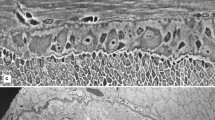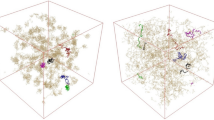Summary
Coiled bodies were investigated by means of ultrastructural cytochemistry. Preferential staining methods for localization of various proteins (ribonucleoproteins, basic proteins, phosphoproteins and glycoproteins) and DNA were applied. The results of cytochemical tests revealed that coiled bodies have a proteinaceous nature. They are composed of ribonucleoproteins, probably of nucleolar origin. They also contain phosphoproteins and glycoproteins but lack cytochemically detectable DNA. Coiled bodies present ultrastructural and cytochemical characteristics similar to the fibrillar part of the nucleous and to the interchromatin granules. The origin and possible functional role of coiled bodies are briefly discussed.
Similar content being viewed by others
References
Ainsworth SK, Karnovsky MJ (1972) An ultrastructural staining method for enhacing the size and electron opacity of ferritin in thin sections. J Histochem Cytochem 20:225–229
Ainsworth SK, Ito S, Karnovsky MJ (1972) Alcaline bismuth reagent for high resolution ultrastructural demonstration of periodate-reactive sites. J Histochem Cytochem 20:995–1005
Bernhard W (1969) A new staining procedure for electron microscopical cytology. J Ultrastruct Res 27:250–265
Bouteille M, Laval M, Dupuy-Coin AM (1974) Localization of nuclear functions as revealed by ultrastructural autoradiography and cytochemistry. In: Busch H (ed) The cell nucleus, vol 1. Academic Press, New York, pp 3–71
Brasch K, Peters KE (1985) Nuclar protein, matrix and structural changes in rooster liver after estrogenic induction of vitellogenesis. Biol Cell 54:109–122
Brusa A (1952) A propos de la structure du noyau de la cellule nerveuse. Anat Anz 98:343–352
Buchwalow IB, Unger E (1977) Enzyme activity of nuclear ribonucleoproteins. Exp Cell Res 106:139–150
Cajal SR (1903) Un sencillo mètodo de coloraciòn selectiva del reticulo protoplàsmico y sus efectos en los diversos òrganos nerviosos de vertebrados e invertebrados. Trab Lab Invest Biol 2:129–221
Courtens J-L, Loir M (1981) Ultrastructural detection of basic nucleoproteins: alcoholic phosphotungstic acid does not bind to arginine residues. J Ultrastruct Res 74:322–326
Derenzini M, Viron A, Puvion-Dutilleul F (1982) The Feulgen-like osmium ammine reaction as a tool to investigate chromatin structure in thin sections. J Ultrastruct Res 80:133–147
Fakan S, Puvion E, Spöhr G (1976) Localization and characterization of newly synthesized nuclear RNA in isolated rat hepatocytes. Exp Cell Res 99:155–164
Grillo MA (1970) Cytoplasmic inclusions resembling nucleoli in sympathetic neurons of adult rats. J Cell Biol 45:100–117
Hardin H, Spicer SS, Greene WB (1969) The paranucleolar structure, accessory body of Cajal, sex chromatin, and related structures in nuclei of rat trigeminal neurons: A cytochemical and ultrastructural study. Anat Res 164:403–432
Hervàs JP, Villegas J, Crespo D, Lafarga M (1980) Coiled bodies in supraoptic nuclei of the rat hypothalamus during the postnatal period. Am J Anat 159:447–454
Jensen AL, Brasch K (1985) Nuclear development in locust fat body: the influence of juvenile hormone on inclusion bodies and the nuclear matrix. Tissue Cell 17:117–130
Kinderman NB, La Velle A (1976) A hucleolus-associated coiled body. J Neurocytol 5:545–550
Lafarga M, Crespo D, Villegas J (1983a) Nuclear inclusions in immature glial cells of rat hypothalamus during the postnatal period. Anat Embryol 167:263–271
Lafarga M, Hervàs JP, Santa-Cruz MC, Villegas J, Crespo D (1983b) The accessory body of Cajal in the neuronal nucleus: A light and electron microscopic approach. Anat Embryol 166:19–30
Le Beux YJ (1971) An ultrastructural study of the neurosecretory cells of the medial vascular prechiasmatic gland, the preoptic recess and the anterior part of the suprachiasmatic area. I. Cytoplasmic inclusions resembling nucleoli. Z Zellforsch 144:404–440
Leduc EH, Bernhard W (1967) Recent modification of the glycol methacrylate embedding procedure. J Ultrastruct Res 19:196–199
Masurovsky EB, Bunge MB, Bunge RP (1967) Cytological studies of organotypic cultures of rat dorsal root ganglia following X-irradiation in vitro. I. Changes in neurons and satellite cells. J Cell Biol 32:467–496
Monneron A, Bernhard W (1969) Fine structural organization of the interphase nucleus in some mammalian cells. J Ultrastruct Res 27:266–288
Moreno Diaz De La Espina S, Risueno C, Medina FJ (1982) Ultrastructural, cytochemical and autoradiographic characterization of coiled bodies in the plant cell nucleus. Biol Cell 44:229–238
Moyne G (1980) Methods in ultrastructural cytochemistry of the cell nucleus. Prog Histochem Cytochem 13:1–56
Nash RE, Puvion E, Bernhard W (1975) Perichromatin fibrils as components of rapidly labelled extranucleolar RNA. J Ultrastruct Res 53:395–405
Peters A, Palay SL, Webster HF (1976) The fine structure of the nervous system: The neurons and supporting cells. WB Saunders, Philadelphia, pp 56–58
Radouco-Thomas C, Nosal GL, Radouco-Thomas S (1971) The nuclear-ribosomal system during neuronal differentiation and development. In: Paoletti R, Davison AN (eds) Chemistry and brain development. Plenum Press, New York, pp 291–308
Recher L, Parry N, Whitescarver J, Briggs L (1972) Lead-positive nuclear structures and their behavior under the effect of various drugs. J Ultrastruct Res 38:398–412
Seve AP, Hubert J, Bouvier D, Masson C, Geraut G, Bouteille M (1984) In situ distribution in different cell types of nuclear glycoconjugates detected by the lectins. J Submicrose Cytol 16:631–641
Vagner-Capodano AM, Mauchamp J, Stahl A, Lissitzky S (1980) Nucleolar budding and formation of nuclear bodies in cultured thyroid cells stimulated by thyrotropin clibutyrilcyclin AMP, and prostaglandin E2. J Ultrastruct Res 70:37–51
Wassef M (1979) A cytochemical study of interchromatin granules. J Ultrastruct Res 69:121–133
Wassef M, Burglen J, Bernhard W (1979) A new method for visualization of preribosomal granules in the nucleolus after acetylation. Biol Cell 34:153–158
Zaręba-Kowalska A, Borowicz J (1987) Effect of transient cerebral ischemia on the ultrastructure of the gigantocellular region of the medullary reticular formation in the rat. Neuropatol Pol 25:117–130
Author information
Authors and Affiliations
Rights and permissions
About this article
Cite this article
Zaręba-Kowalska, A. Cytochemical observations of the coiled bodies in neurons of rat sympathetic ganglia. Histochemistry 91, 251–256 (1989). https://doi.org/10.1007/BF00490140
Accepted:
Issue Date:
DOI: https://doi.org/10.1007/BF00490140




